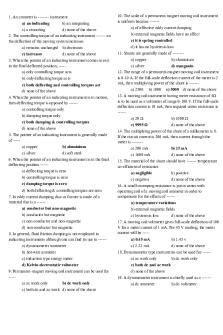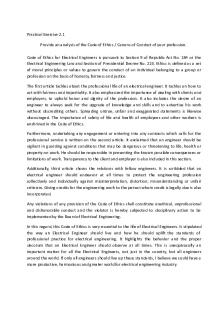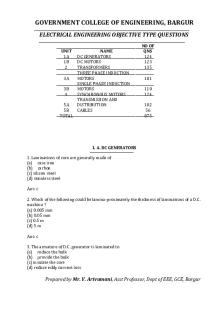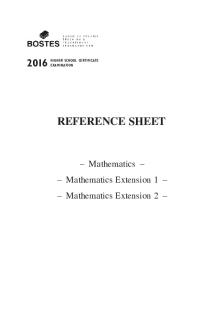EE101 3 -ACTheory -Electrical Engineering uom PDF
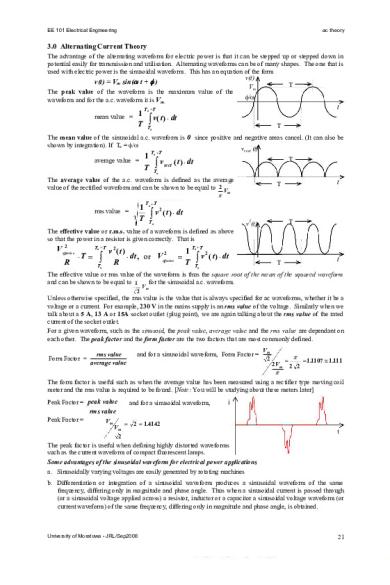
| Title | EE101 3 -ACTheory -Electrical Engineering uom |
|---|---|
| Author | Anonymous User |
| Course | Engineering |
| Institution | University of Moratuwa |
| Pages | 10 |
| File Size | 621.8 KB |
| File Type | |
| Total Downloads | 83 |
| Total Views | 134 |
Summary
These slides belong University of Moratuwa Sri Lanka and are about the AC theory in Electrical Engineering....
Description
EE 101 Electrical Engineering
ac theory
3.0 Alternating Current Theory The advantage of the alternating waveform for electric power is that it can be stepped up or stepped down in potential easily for transmission and utilisation. Alternating waveforms can be of many shapes. The one that is used with electric power is the sinusoidal waveform. This has an equation of the form v(t) v(t) = Vm sin(ω t + φ ) T Vm The peak value of the waveform is the maximum value of the φ/ω waveform and for the a.c. waveform it is Vm. mean value =
1 T
t
To +T
∫ v( t ) ⋅ dt
T
To
The mean value of the sinusoidal a.c. waveform is 0 since positive and negative areas cancel. (It can also be shown by integration). If To = φ/ω vrect (t) To +T 1 T average value =
∫ vrect ( t ) ⋅ dt
T
To
The average value of the a.c. waveform is defined as the average value of the rectified waveform and can be shown to be equal to 2 V m π
1 T
rms value =
t
T
T o +T
∫v
2
( t ) ⋅ dt T
v2(t)
To
The effective value or r.m.s. value of a waveform is defined as above so that the power in a resistor is given correctly. That is 2 V effective
R
To +T
⋅T =
∫
To
v 2( t) 1 2 ⋅ dt , or Veffective = R T
To +T
∫v
2
( t ) ⋅ dt
t
T
To
The effective value or rms value of the waveform is thus the square root of the mean of the squared waveform for the sinusoidal a.c. waveform. and can be shown to be equal to 1 2
Vm
Unless otherwise specified, the rms value is the value that is always specified for ac waveforms, whether it be a voltage or a current. For example, 230 V in the mains supply is an rms value of the voltage. Similarly when we talk about a 5 A, 13 A or 15A socket outlet (plug point), we are again talking about the rms value of the rated current of the socket outlet. For a given waveform, such as the sinusoid, the peak value, average value and the rms value are dependant on each other. The peak factor and the form factor are the two factors that are most commonly defined. Form Factor =
rms value average value
and for a sinusoidal waveform, Form Factor =
Vm 2
2 Vm
=
π 2 2
= 1 .1107 ≅ 1 .111
π The form factor is useful such as when the average value has been measured using a rectifier type moving coil meter and the rms value is required to be found. [Note: You will be studying about these meters later]
Peak Factor = peak value rms value Peak Factor = Vm
Vm 2
and for a sinusoidal waveform,
i
= 2 = 1.4142
t
The peak factor is useful when defining highly distorted waveforms such as the current waveform of compact fluorescent lamps. Some advantages of the sinusoidal waveform for electrical power applications a. Sinusoidally varying voltages are easily generated by rotating machines b. Differentiation or integration of a sinusoidal waveform produces a sinusoidal waveform of the same frequency, differing only in magnitude and phase angle. Thus when a sinusoidal current is passed through (or a sinusoidal voltage applied across) a resistor, inductor or a capacitor a sinusoidal voltage waveform (or current waveform) of the same frequency, differing only in magnitude and phase angle, is obtained.
University of Moratuwa - JRL/Sep2008
21
EE 101 Electrical Engineering
ac theory
If i(t) = Im sin (ωt+φ), for a resistor, v(t) = R.i(t) = R.Im sin ( ωt+ φ) = Vm sin ( ωt+ φ) − magnitude changed by R but no phase shift for an inductor,
v( t ) = L.
di d = L. ( I m sin (ω t + φ)) = L . ω. I m cos (ω t + φ) = L . ω. I m sin ( ω t + φ + π / 2) dt dt
− magnitude changed by Lω and phase angle changed by π/2 for a capacitor,
v( t ) =
1 1 1 −1 . ∫ i ⋅ dt = ∫ I m sin (ω t + φ ) ⋅ dt = . I m cos (ω t + φ ) = . I m sin (ω t + φ − π / 2) C C C⋅ ω C ⋅ω
− magnitude changed by 1/Cω and phase angle changed by −π/2
c. Sinusoidal waveforms have the property of remaining unaltered in shape when other sinusoids having the same frequency but different in magnitude and phase are added to them. A sin (ωt+α) + B sin (ωt+β) = A sin ωt. cos α + Α cos ωt. sin α + B sin ωt. cos β + B cos ωt. sin β = (A. cos α + B. cos β) sin ωt + (A. sin α + B. sin β) cos ωt = C sin (ωt + φ), where C and φ are constants obtained from trigonometry. d. Periodic, but non-sinusoidal waveforms can be broken up to its fundamental and harmonics. e. Sinusoidal waveforms can be represented by the projections of a rotating phasor. a(t)
3.1 Phasor Representation of Sinusoids You may be aware that sin θ can be written in terms of exponentials and complex numbers. i.e. e or e
jθ
ω
= cos θ + j sin θ
jω t
Amsin ω t
P
O
ωt
X
O
t
= cos ω t + j sin ω t
T
Consider a line OP of length Am which is in the horizontal direction OX at time t=0. If OP rotates at an angular velocity ω , then in time t its position would correspond to an angle of ω t. The projection of this rotating phasor OP (a phasor is somewhat similar to a vector, except that it does not have a physical direction in space but a phase angle) on the y-axis would correspond to OP sin ωt or Am sin ω t and on the x-axis would correspond to Am cos ω t. Thus the sinusoidal waveform can be thought of being the jωt projection on a particular direction of the complex exponential e . a(t)
P ω φ 0
A msin ( ω t+φ)
R ωt
X
0
0
t
A φ
P R
T If we consider more than one phasor, and each phasor rotates at the same angular frequency, then there is no relative motion between the phasors. Thus if we fix the reference phasor OR in a particular reference direction (without showing its rotation), then all others phasors moving at the same angular frequency would also be fixed at a relative position. Usually this reference direction is chosen as horizontal on the diagram for convenience. Rotating Phasor diagram
Am
0
φ
A=
P
R
0
φ Ax
Am 2 Ay reference direction
Phasor diagram
University of Moratuwa - JRL/Sep2008
22
EE 101 Electrical Engineering
ac theory
It is also usual to draw the Phasor diagram using the rms value A of the sinusoidal waveform, rather than with the peak value Am. This is shown on an enlarged diagram. Thus unless otherwise specified it is the rms value that is drawn on a phasor diagram. It should be noted that the values on the phasor diagram are no longer time variables. The phasor A is characterised by its magnitude A and its phase angle φ. These are also the polar co-ordinates of the phasor and is commonly written as A φ . The phasor A can also be characterised by its cartesian co-ordinates Ax and Ay and usually written using complex numbers as A = Ax + j Ay. Note: In electrical engineering, the letter j is always used for the complex operator is regularly used for electric current. It is worth noting that
− 1 because the letter i
2 2 A A = A x + A y and that tanφ = y or φ = tan − 1 Ay
Ax
Ax
Also, Ax = A cos φ,
jφ
Ay = A sin φ and A e = A cos φ + jA sin φ = Ax + j Ay
Note: If the period of a sinusoidal waveform is T, then the corresponding angle would be ω T. Also, the period of a waveform corresponds to 1 complete cycle or 2 π radians or 3600. ∴ ω T = 2π π 3.2 Phase difference Consider the two waveforms Amsin ( ω t+φ1) and Bmsin ( ω t+φ2) as shown in the figure. It can be seen that they have different amplitudes and different phase angles with respect to a common reference. φ2− φ 1 y(t) Bmsin ( ωt+ φ 2) A msin (ω t+φ 1 )
ωt
φ1 O φ2 − φ1
φ2
B=
Bm 2
ωT j(ω ωt+φ ) A These two waveforms can also be represented by either rotating phasors Am e 1 A= m j (ω ωt+φ ) and Bm e 2 with peak amplitudes Am and Bm, or by a normal phasor diagram 2 φ2-φ1 with complex values A and B with polar co-ordinates A φ1 and B φ2 as φ1 0 shown . Any particular value (such as positive peak, or zero) of a(t) is seen to occur at a time T after the corresponding value of b(t). i.e. the positive peak Am occurs after an angle (φ2 −φ1) after the positive peak Bm. Similarly the zero of a(t) occurs after an angle (φ2 −φ1) after the corresponding zero of b(t). In such a case we say that the waveform b(t) leads the waveform a(t) by a phase angle of (φ2 −φ1). Similarly we could say that the waveform a(t) lags the waveform b(t) by a phase angle of (φ2 −φ1). [Note: Only the angle less than 180o is used to specify whether a waveform leads or lags another waveform]. We could also define, lead and lag by simply referring to the phasor diagram. Since angles are always measured anticlockwise (convention), we can see from the phasor diagram, that B leads A by an angle of (φ2 −φ1) anticlockwise or that A lags B by an angle (φ2 −φ1). Addition and subtraction of phasors can be done using the same parallelogram and triangle laws as for vectors, generally using complex numbers. Thus the addition of phasor A and phasor B would be A + B = (A cos φ 1 + j A sin φ1) + (B cos φ2 + j B sin φ2)
C B
= (A cos φ 1 + B cos φ 2) + j (A sin φ 1 + B sin φ 2) = Cx + jCy = C φ c = C
φ2 0
A
φ1
where C = C 2 + C 2 = ( A cosφ + B cosφ ) 2 + ( A sinφ + B sinφ ) 2 1 2 1 2 x y and
φ c = tan −1
Cy
( A sin φ 1+ B sin φ 2) = tan −1 C x ( A cos φ 1 + B cos φ 2)
University of Moratuwa - JRL/Sep2008
23
EE 101 Electrical Engineering
ac theory
Example Find the addition and the subtraction of the two complex numbers given by 10 30o and 25 48o. Addition = 10 30o + 25 48o = 10(0.8660 + j 0.5000) + 25(0.6691 + j 0.7431) = (8.660 + 16.728) + j (5.000 + 18.577) = 25.388 + j 23.577 = 34.647 42.9o Subtraction = 10 30o − 25 48o = (8.660 − 16.728) + j (5.000 − 18.577) = − 8.068 − j 13.577 = 15.793 239.3o Multiplication and division of phasors is most easily done using the polar form of complex numbers. Thus the multiplication of phasor A and phasor B would be φ
φ
A * B = A φ1 * B φ 2 = A e j 1 ∗ B e j
2
= A* B e
j( φ + φ ) 1
2
= A*B φ1+ φ2 = C φ c
where C = A* B and φc = φ 1+ φ2 In a similar way, it can be easily seen that for division
C = A/ B and φc = φ1− φ2 Thus, whenever we need to do addition and subtraction, we use the cartesian form of complex numbers, whereas for multiplication or division we use the polar form. Example Find the multiplication and the division of the two complex numbers given by 10 30o and 25 48o. Multiplication = 10 30o * 25 48o = 250 78o Division = 10 30o ÷ 25 48o = 0.4 −18o 3.3 Currents and voltages in simple circuit elements 3.3.1 Resistor i (t)
R v (t) v(t) = R.i(t) R
I
for a sinusoid, consider i(t) =Real part of [ Im e(jωt+θ) ] or Im cos (ωt+θ)
∴v(t) = Real [R. Im e(jωt+θ) ] = Real [Vm. e(jωt+θ)]
Imcos ω t
or v(t) = R.Im cos (ωt+θ) = Vm cos (ωt+θ )
Vmcos ωt
∴Vm = R.Im and Vm/√2 = R.Im/√2
O
ωt
i.e. V = R . I
ωT Note: V and I are rms values of the voltage and I V current and no additional phase angle change O has occurred in the resistor . Phasor diagram Note also that the power dissipated in the resistor R is equal to R . I 2 = V . I 3.3.2 Inductor V
i (t)
I
L
v (t) d i( t ) v( t ) = L dt j ωL
for a sinusoid, consider i(t) =Real part of [ Im e(jωt+θ) ] or Im cos (ωt+θ) ∴v(t) = Real [L. d Im e(jωt+θ) ] = Real [L. j ω. Im ej(ωt+θ) ] = Real [j Vm ej(ωt+θ) ] dt or v(t) = L. d Im cos (ωt+θ) = −L.ω.Im sin (ωt+θ) = L. ω.Im cos (ωt+ θ+π/2) dt Imcos ωt =Vm cos (ωt+θ+π/2) Vmsin ω t ∴Vm = ωL.Im and Vm/√2 = ωL.Im/√2 π/2 O ωt
V It can be seen that the rms magnitude of voltage is related to the rms magnitude of current by the multiplying factor ωL. It also seen that the voltage waveform leads the current waveform by 90o or π/2 radians or that the current waveform lags the voltage waveform by 90o for an inductor . Thus it is usual to write the relationship as V = jωL.I or V = ω L.I 90 ο
ωT O
V
I
Phasor diagram The impedance Z of the inductance may thus be defined as jω L , and V = Z . I corresponds to the generalised form of Ohm’s Law. Remember also that the power dissipation in a pure inductor is zero, as energy is only stored and as there is no resistive part in it, but that the product V . I is not zero.
University of Moratuwa - JRL/Sep2008
24
EE 101 Electrical Engineering
3.3.3
ac theory
Capacitor for a sinusoid, consider i(t) =Real part of [ Im ej(ωt+θ) ] or Im cos (ωt+θ) i (t) v(t) = Real [ 1 I e j ( ω t + θ ) . dt ] = Real [ 1 . Im e(jωt+θ) ] = Real [ 1 Vm e(jωt+θ) ] ∫ C m j C . jω v (t) or v(t) = 1 I cos(ω t +θ ). dt = 1 .Im sin (ωt+θ) = 1 .Im cos (ωt+θ−π/2) m C∫ Cω Cω 1 v ( t ) = ∫ i ( t ). dt =V cos ( ωt+ θ−π /2 ) m Imcos ω t C 1 ∴Vm = 1 .Im and Vm/√2 = 1 .Im/√2 Vmsin ω t I jω C ωC ωC O π/2 ωt C
V It can be seen that the rms magnitude of voltage is related to the rms magnitude of current by the multiplying factor 1 . ωC It also seen that the voltage waveform lags the current waveform by 90o or π/2 radians or that the current waveform leads the voltage waveform by 90o for a capacitor.
ωT
I V
O
Phasor diagram or V = 1 .I 90ο ωC The impedance Z of the inductance may thus be defined as 1 , and V = Z . I corresponds to the generalised jω C form of Ohm’s Law.
Thus it is usual to write the relationship as V = 1 .I jω C
Remember also that the power dissipation in a pure capacitor is zero, as energy is only stored and as there is no resistive part in it, but that the product V . I is not zero. 3.4 Impedance and Admittance in an a.c. circuit The impedance Z of an a.c. circuit is a complex quantity. It defines the relation between the complex rms voltage and the complex rms current. Admittance Y is the inverse of the impedance Z. V = Z . I,
I = Y.V
where
Z = R + j X,
and
Y=G+jB
It is usual to express Z in cartesian form in terms of R and X, and Y in terms of G and B. The real part of the impedance Z is resistive and is usually denoted by a resistance R, while the imaginary part of the impedance Z is called a reactance and is usually denoted by a reactance X. It can be seen that the pure inductor and the pure capacitor has a reactance only and not a resistive part, while a pure resistor has only resistance and not a reactive part. Thus Z = R + j 0 for a resistor, Z = 0 + jω ωL for an inductor, and Z = 1 = 0 − j 1 for a capacitor. jω C ωC The real part of the admittance Y is a conductance and is usually denoted by G, while the imaginary part of the admittance Y is called a susceptance and is denoted by B. Relationships exist between the components of Z and the components of Y as follows. −X R 1 1 R − j X so that , and B = 2 G = 2 = 2 G + j B =Y = = 2 2 Z R +jX R + X R +X R +X2 The reverse process can also be similarly done if necessary. However, it must be remembered that in a complex circuit, G does not correspond to the inverse of the resistance R but its effective value is influenced by X as well as seen above. 3.5 Simple Series Circuits In the case of single elements R, L and C we found that the angle difference between the voltage and the current was either zero, or ± 90o. This situation changes when there are more than one component in a circuit. 3.5.1 R-L series circuit V R VR
I
jωL
VL
University of Moratuwa - JRL/Sep2008
In the series R-L circuit, considering current I as reference VR = R.I, VL = jωL.I, and V = VR + VL
∴ V = (R + jωL).I so that the total series impedance is Z = R + jωL
VL
V
VL
φ VR I Phasor diagram
25
EE 101 Electrical Engineering
ac theory
The above phasor diagram has been drawn with I as reference. [i.e. I is drawn along the x-axis direction]. The current was selected as reference in this example, because it is common to both the resistance and the inductance and makes the drawing of the circuit diagram easier. In this diagram, the voltage across the resistor VR is in phase with the current, where as the voltage across the inductor VL is 90o leading the current. The total voltage V V is then obtained by the phasor addition (similar to vector addition) of VR and VL. φ If the total voltage was taken as the reference, the diagram would just rotate as VL I shown. In this diagram, the current is seen to be lagging the voltage by the VR same angle that in the earlier diagram the voltage was seen to be leading the current. VL has been drawn from the end of VR rather than from the origin for Phasor diagram ease of obtaining the resultant V from the triangular law. In an R-L circuit, the current lags the voltage by an angle less than 90o and the circuit is said to be inductive. Note that the power dissipation can only occur in the resistance in the circuit and is equal to R . I 2 and that this is not equal to product V . I for the circuit. 3.5.2 R-C series circuit
R
I
In the series R-C circuit,
V
VR = R.I, VC =
1
I
jωC
VR φ
.I=−j 1 .Ι ωC jω C 1
V
and V = VR + VC
VR
VC so that the total series impedance is Z = R +
∴ V = (R + 1 ).I jω C
VC
Phasor diagram VR
1 j ωC
I
VL
φ
The phasor diagrams has been drawn first with current I as reference and then with voltage V as reference.
V
In an R-C circuit, the current leads the voltage by an angle less than 90o and the circuit is said to be capacitive. Note that the power dissipation can only occur in the resistance in the circuit and is equal to R . I 2 and that this is not equal to product V . I for the circuit. 3.5.3 L-C series circuit V 1 jω C
j ωL
I
VL = jωL.I, VC =
VL
VC
VL
In the series L-C circuit, .I = − j 1 ωC j ωC 1
V
∴ V = (jωL + 1 ).I
I VC
and V = VL + VC
VL VC or V
I
Phasor
= jωL − j 1 ωC j ωC jω C It is seen that the total impedance is purely reactive, and that all the voltages in the circuit are inphase but perpendicular to the current. The resultant voltage corresponds to the algebraic difference of the two voltages VL and VC and the direction could be either up or down depending on which voltage is more. so that the total series impedance is ...
Similar Free PDFs
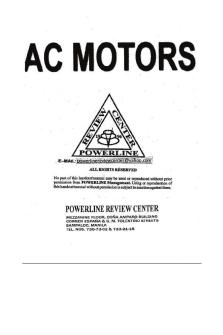
AC Motors101 Electrical Engineering
- 17 Pages

Electrical engineering - Wikipedia
- 18 Pages
Popular Institutions
- Tinajero National High School - Annex
- Politeknik Caltex Riau
- Yokohama City University
- SGT University
- University of Al-Qadisiyah
- Divine Word College of Vigan
- Techniek College Rotterdam
- Universidade de Santiago
- Universiti Teknologi MARA Cawangan Johor Kampus Pasir Gudang
- Poltekkes Kemenkes Yogyakarta
- Baguio City National High School
- Colegio san marcos
- preparatoria uno
- Centro de Bachillerato Tecnológico Industrial y de Servicios No. 107
- Dalian Maritime University
- Quang Trung Secondary School
- Colegio Tecnológico en Informática
- Corporación Regional de Educación Superior
- Grupo CEDVA
- Dar Al Uloom University
- Centro de Estudios Preuniversitarios de la Universidad Nacional de Ingeniería
- 上智大学
- Aakash International School, Nuna Majara
- San Felipe Neri Catholic School
- Kang Chiao International School - New Taipei City
- Misamis Occidental National High School
- Institución Educativa Escuela Normal Juan Ladrilleros
- Kolehiyo ng Pantukan
- Batanes State College
- Instituto Continental
- Sekolah Menengah Kejuruan Kesehatan Kaltara (Tarakan)
- Colegio de La Inmaculada Concepcion - Cebu


